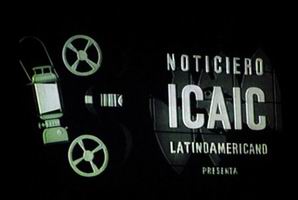
The Latin America ICAIC (Cuban Institute of the Art and Industry of Cinematography) Newsreel will be recovered. If I’m not mistaken, it is considered a part of Cuba’s and the world’s heritage of documentary news by UNESCO and will be treated with all the technological marvels that restore the old audiovisuals almost for eternity.
Going to the movies was once important, when we looked through the papers to catch the news of the premieres: Do you remember the theater circuits such as Infanta-Acapulco-Lido-Santa Catalina and Payret-Trianon-Ambassador-Alameda? The Metropolitan circuit escapes me, and I’ve forgotten which circuit the Yara theater was on, what to this day continues to be called Radiocentro.
But when there was a movie premiere, or a second run in the neighborhood theaters, the program included the inevitable Weekly ICAIC Newsreel. The great memories of a different visuality, with music that sounded wonderful to my eager ears. Pello el Afrokán may have shared the soundtrack with Rick Wakeman, Bourke with Aretha Franklin, Hendrix with Tata Guines.
These people were “the latest,” they even wore jeans! No one told me, I saw it myself as I studied very close to the ICAIC and went for an afternoon snack for what remained of sodas at the TenCent on 23rd, directly facing the Atlantic building, the film institute headquarters. Those gods with their great manes of hair (by the standards of the time) snacking there too and I alternately dazzled with Adriano, Tito, Livio. Beautiful and impossible with their royal names and their “swing”.
Those were the golden years of the news, where Santiago Alvarez did whatever he wanted, and Sundays I always went to the movies and waited for the news with and I really enjoyed it (a bad habit I never lost) and without knowing it, but intuiting it, because the news created a new artistic jewel every week.
They covered the most important events in the world, but especially, they documented those years in Cuba. Parades, the latest plan, the hijacking of planes (they called them “diversions” when they came from there to here), all with the unmistakable voice of Julio Batista as corporate branding.
When Cubans saw a Jumbo jet for the first time in their lives, thanks to the black-and-white ICAIC Newsreel, I had been hanging out with my brothers at the airport and from the terrace of the original building in Boyeros the imposing nose cone of that giant “diversion” seemed to me a symbol of modernity; in the end, like a chronicle of the past, of that heroic part I felt we were living in those years, there is also a sentiment of loss, preserved in the testimony that will now be “re-mastered,” digitalized and treated with other technological tenderness; the testimony of the cane we cut, the soil we carried in sacks, the coffee we harvested, the anthems we chanted, and the guns we wielded, the uniquely grey clothes in which we believed we were heading along the path toward a perfect place.
June 27 2012
